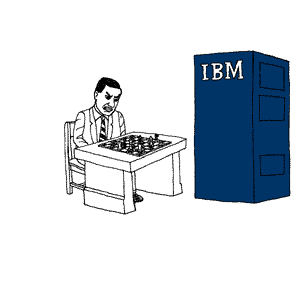Cognitive Science is a computational study of the mind: McGill Cognitive Science
One of the biggest accomplishments in the field of Artificial Intelligence was when Deep Blue, a chess playing program developed at IBM, beat the world chess champion, Garry Kasparov. But this was in the early days of artificial intelligence -- when computer scientists still weren't sure on what it means for a machine to be intelligent. Chess is a well-known thinking-man's game, and at first glance it seems that a machine can only be worthy of being dubbed intelligent if it performs competitively on intelligent-people activities such as chess.
Chess: Human vs. Machine: Slate article about Deep Blue
Given the plethora of tasks that humans can effortlessly perform in daily life, is engineering a machine to rival humans on just one such task bringing researchers any closer to building truly intelligent machines?
The problem with chess is that it has a "finite universe problem" -- there is a finite number of primitives (the chess pieces) which can be manipulated by choosing a move from a finite set of allowable actions. But if we think of normal life (going to work, eating dinner, talking to a friend) as a game, then it is not hard to see that most everyday situations involving humans involve a sea of infinite objects (just look around and name all the different objects you can see around you!) and an equally capacious space of allowable actions (consider all the things you could with all those objects around you!). Intelligence is what allows us to cope with the complexities of the universe by focusing our attention on a limited set of relevant variables -- but the working set of objects/concepts we must consider at any single instant is chosen from a seemingly infinite set of alternatives.
I believe that everyday human-level visual intelligence is greatly undervalued by people -- and there is a very good reason for this! The ability to make sense of what is going on in a single picture is such a trivial and autonomous task for humans, that we don't even bother quantifying just how good we are at it. But let me reassure you that automated image understanding is no trivial feat. The world is not composed of 20 visual object categories and the space of allowable and interpretable utterances we could associate with a static picture is seemingly infinite. While the 20 category object detection task (as popularized by the PASCAL VOC) does have a finite universe problem, the grander version of the vision master problem (a combination of detection/recognition/categorization where you can interpret an input any way you like) is much more complex and mirrors the structure of the external world well.
Robotics Challenge: Build a Robot like Bender
Any application which calls for automated analysis of images requires vision. A robot, if it is to be successful interacting with the world and performing useful tasks, needs to perceive the external world and organize it. While some see vision as just one small piece of the "Robotics Challenge" (build a robot and make it do cool stuff), it totally unclear to me where to draw the boundary between low-level pixel analysis and high-level cognitive scene understanding. Over the years, I have been thinking more and more about this problem, and I've convinced myself that the interesting part of vision is precisely at the boundary between what is commonly thought of as low-level representation of signal and what is considered high-level representation of visual concepts. While some view computer vision as "applied mathematics" or "applied machine learning" or "image processing in disguise", I passionately believe the following:
Computer Vision is Artificial Intelligence



Tidak ada komentar:
Posting Komentar